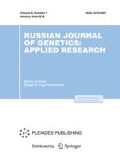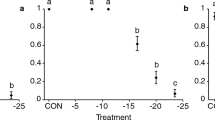Abstract
The pathogenic Wolbachia strain wMelPop is detected in the central nervous system, muscles, and retina of Drosophila melanogaster. It reduces the host lifespan by a factor of two. This fact makes it promising for the control of insect pests and vectors of human diseases. Any symbiotic association is exposed to various stress factors: starvation, heat, cold and etc., which affect the symbiont interaction significantly. This study considers the influence of low (16°C) and high (29°C) temperature on the survival and lifespan of D. melanogaster females infected with the Wolbachia strain wMelPop. The ultrastructure of brain cells and distribution of the bacteria in this cells were studied. On day 7 of exposure to high temperature, electron-dense bodies occur in brain cells of the flies, resembling degrading bacteria. The amount of these bodies increases dramatically by day 13 of incubation at 29°C. On the basis of population and EM analysis, we identified the critical period (7–13 days) of high temperature influence, which dramatically decreases the survival of D. melanogaster.
Similar content being viewed by others
References
Bordenstein, S.R. and Bordenstein, S.R., Temperature affects the tripartite interactions between bacteriophage WO, Wolbachia, and cytoplasmic incompatibility, PLoS One, 2011, vol. 6, p. e29106.
Breeuwer, J.A.J., High temperatures eliminate Wolbachia, a cytoplasmic incompatibility inducing endosymbiont, from the two-spotted spider mite, Exp. Appl. Acarol., 1999, vol. 23, pp. 871–881.
Chapman, R.F. and Page, W.W., Factors affecting the mortality of the grasshopper, Zonocerus variegates, in southern Nigeria, Okeanologiya, 1979, vol. 48, pp. 271–288.
Clark, M.E., Anderson, C., Cande, J., and Karr, T.L., Widespread prevalence of Wolbachia in laboratory stocks and the implications for Drosophila research, Genetics, 2005, vol. 170, pp. 1667–1675.
Cossins, A. and Bowler, K., Temperature Biology of Animals, London: Chapman and Hall, 1987.
Dobson, S.L., Bourtzis, K., Braig, H.R., et al., Wolbachia infections are distributed throughout insect somatic and germ line tissues, Insect. Biochem. Mol. Biol., 1999, vol. 29, pp. 153–160.
Hayes, S.F. and Burgdorfer, W., Reactivation of Rickettsia rickettsii in Dermacentor andersoni ticks: an ultrastructural analysis, Infect. Immun., 1982, vol. 37, pp. 779–785.
Kushner, D.J., Microbial Life in Extreme Environments, London: Academic Press, 1978.
Kozek, W.J., What is new in the Wolbachia/Diroflaria interaction?, Vet. Parasitol., 2005, vol. 133, pp. 127–132.
Loesel, R., Nässel, D.R., and Strausfeld, N.J., Common design in a unique midline neuropil in the brains of arthropods, Arthropod Struct. Dev., 2002, vol. 31, pp. 77–91.
McGraw, E.A., Merritt, D.J., Droller, J.N., and O’Neill, S.L., Wolbachia density and virulence attenuation after transfer into a novel host, Proc. Natl. Acad. Sci. U.S.A., 2002, vol. 99, pp. 2918–2923.
McMeniman, C.J., Lane, R.V., Cass, B.N., et al., Stable introduction of a life-shortening Wolbachia infection into the mosquito Aedes aegypti, Science, 2009, vol. 323, pp. 141–144.
Min, K.T. and Benzer, S., Wolbachia, normally a symbiont of Drosophila, can be virulent, causing degeneration and early death, Proc. Natl. Acad. Sci. U.S.A., 1997, vol. 94, pp. 10792–10796.
Moreira, L.A., Iturbe-Ormaetxe, I., Jeffery, J.A., et al., A Wolbachia symbiont in Aedes aegypti limits infection with Dengue, Chikungunya, and Plasmodium, Cell, 2009, vol. 139, pp. 1268–1278.
Petavy, G., David, J.R., and Gilbert, P., Viability and rate of development at different temperatures in Drosophila: a comparison of constant and alternating thermal regimes, J. Therm. Biol., 2001, vol. 26, pp. 29–39.
Pizzol, J. and Bolland, P., Effects of endosymbiotic Wolbachia on the diapause in Trichogramma hosts and effects of the diapause on Wolbachia, Entomol. Exp. Appl., 2003, vol. 106, pp. 193–200.
Precht, H.J., Christophersen, H., Hensel, H., and Larcher, W., Temperature and Life, Berlin: Springer-Verlag, 1973.
Rasgon, J.L., Gamston, C.E., and Ren, X., Survival of Wolbachia pipientis in cell-free medium, Appl. Environ. Microbiol., 2006, vol. 72, pp. 6934–6937.
Reynolds, E.S., The use of lead citrate at high ph as an electron-opaque stain for electron microscopy, J. Cell Biol., 1963, vol. 17, pp. 208–212.
Serbus, L.R., Casper-Lindley, C., Landmann, F., and Sullivan, W., The genetics and cell biology of Wolbachia-host interactions, Ann. Rev. Genet., 2008, vol. 42, pp. 683–707.
Terasaki, M., Runft, L.L., and Hand, A.R., Changes in organization of the endoplasmic reticulum during Xenopus oocyte maturation and activation, Mol. Biol. Cell, 2001, vol. 12, pp. 1103–1116.
Thomas, M.B. and Blanford, S., Thermal biology in insectparasite interactions, Trends Ecol. Evol., 2003, vol. 18, no. 7, pp. 344–350.
van Opijnen, T.V. and Breeuwer, J.A.J., High temperatures eliminate Wolbachia, a cytoplasmic incompatibility inducing endosymbions, from the two-spotted mite, Exp. App. Acarol., 1999, vol. 23, pp. 871–881.
Weisman, N.Ya., Ilinskii, Yu.Yu., and Golubovskii, M.D., Population-genetic analysis of lifespan of Drosophila melanogaster: similar effects of the endosymbiont Wolbachia and the oncosuppressor lgl under temperature stress, Zh. Obshch. Biol., 2009, vol. 70, no. 5, pp. 438–447.
Wiwatanaratanabutr, I. and Kittayapong, P., Effects of crowding and temperature on Wolbachia infection density among life cycle stages of Aedes albopictus, J. Invertebr. Pathol., 2009, vol. 102, pp. 220–224.
Zhukova, M.V., Voronin, D.A., and Kiseleva, E.V., High temperature initiates changes in Wolbachia ultrastructure in ovaries and early embryos of Drosophila melanogaster, Cell Tissue Biol., 2008, vol. 2, no. 5, pp. 546–556.
Author information
Authors and Affiliations
Corresponding author
Additional information
Original Russian Text © A.A. Strunov, Yu.Yu. Ilinskii, I.K. Zakharov, E.V. Kiseleva, 2013, published in Vavilovskii Zhurnal Genetiki i Selektsii, 2013, Vol. 17, No. 2, pp. 265–276.
Rights and permissions
About this article
Cite this article
Strunov, A.A., Ilinskii, Y.Y., Zakharov, I.K. et al. Effect of high temperature on survival of Drosophila melanogaster infected with pathogenic strain of Wolbachia bacteria. Russ J Genet Appl Res 3, 435–443 (2013). https://doi.org/10.1134/S2079059713060099
Received:
Accepted:
Published:
Issue Date:
DOI: https://doi.org/10.1134/S2079059713060099




